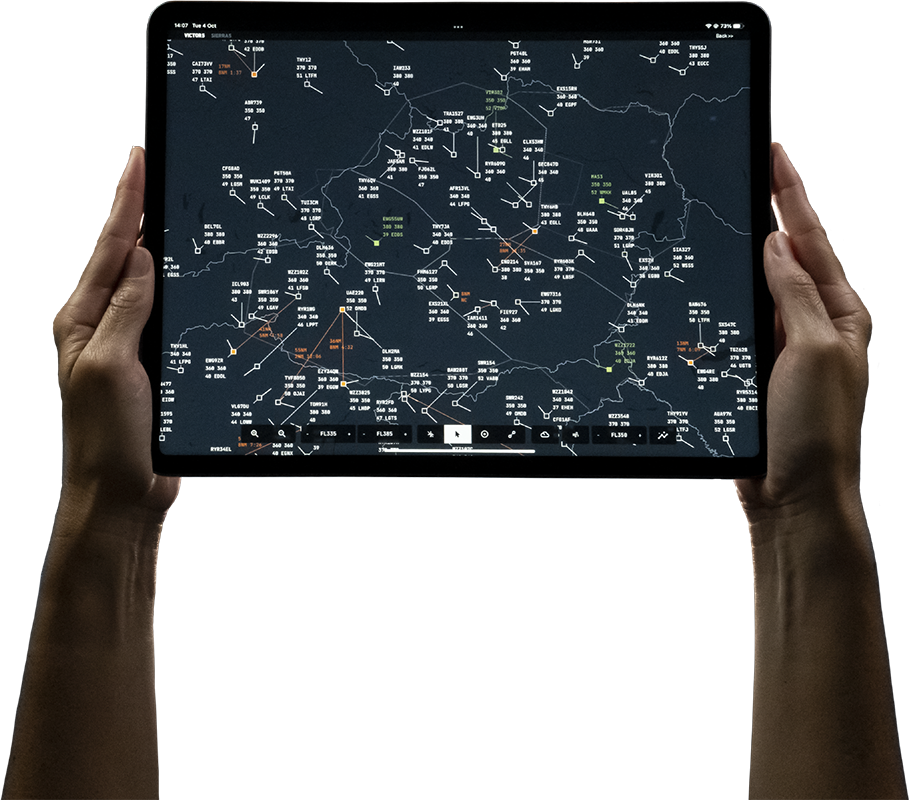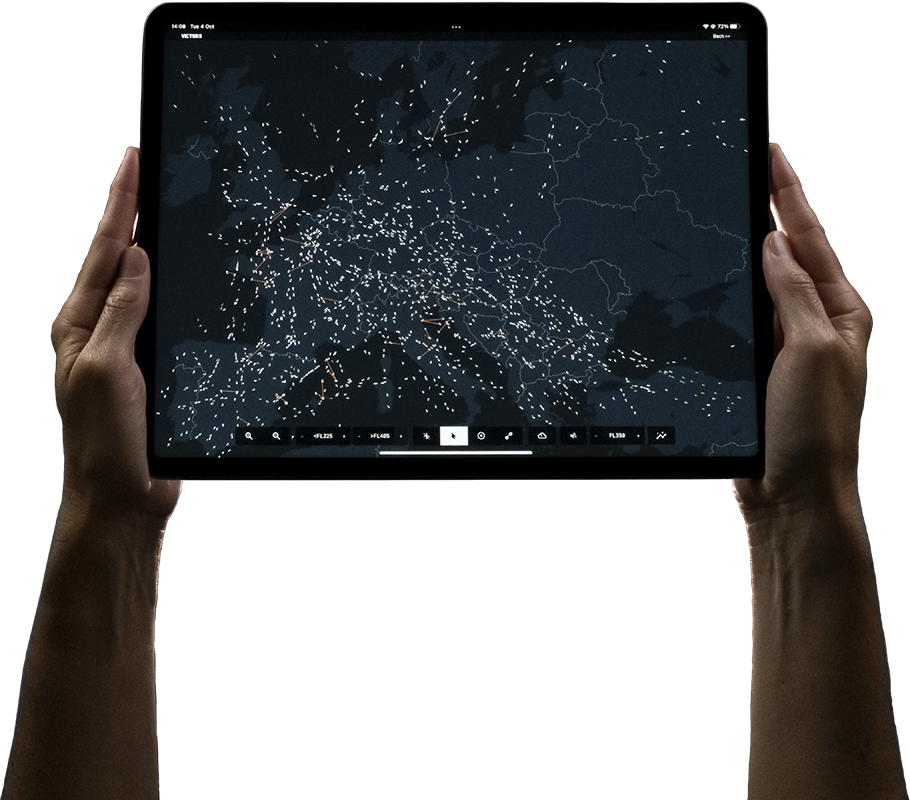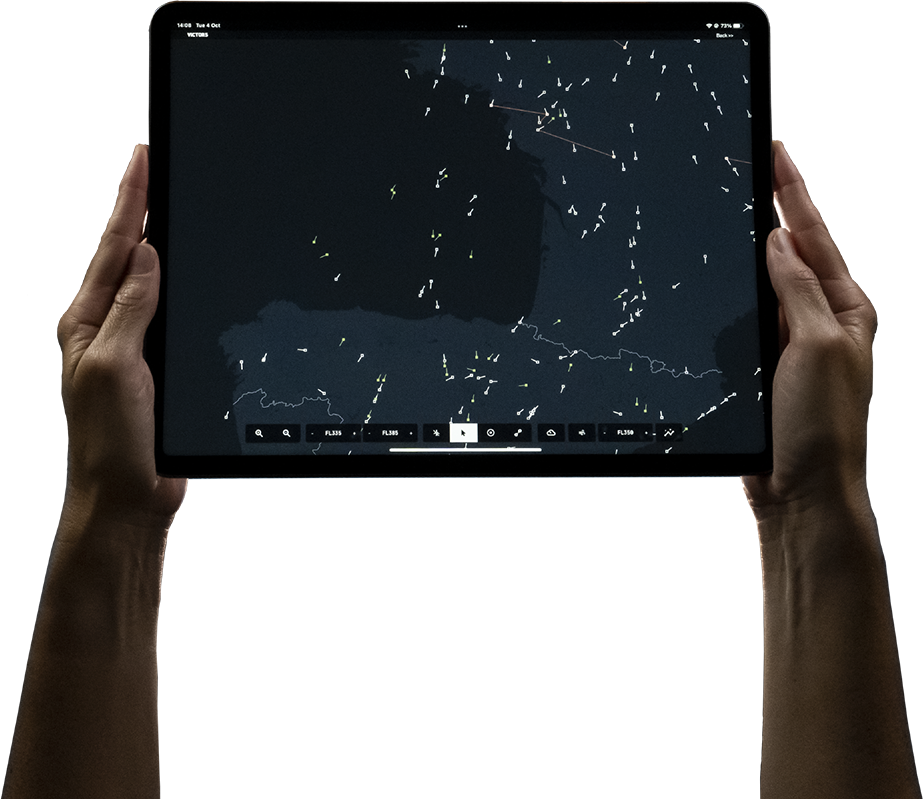A digital assistant platform for air traffic management operations
Victor5 is an end-to-end platform designed to deliver data services to aviation stakeholders, leveraging the power of historical datasets and real time data fusion.
Victor5 focuses on reliability, scalability, and maintainability, enabling the deployment of highly redundant data services that reside simultaneously on on-premises equipment and edge or cloud resources. The platform leverages cutting-edge information technologies and is built on a solid data strategy that is ready for Artificial Intelligence (AI) developments.
The first ready-to-deploy use case for Victor5 is a contingency and situation awareness service for air traffic control operations in the event of service disruption that requires transitioning to ATC Zero or maintaining operations in a degraded mode. In general, Victor5 addresses contingency situations where Air Traffic Control (ATC) sub-systems fail, for en route, approach, or tower. On occasion, the situation may require operational personnel to vacate the ACC or TWR building and relocate to a secondary facility. This facility may or may not have additional backup systems in place. Victor5 allows operational personnel to maintain situational awareness during such transitions to backup equipment but also to maintain degraded operations (if the backup equipment does not exist or is not available due to a common failure with the primary equipment, like radar feed) or to safely clear the skies.


Victor5 assists the operational room with a portable device that meets the following requirements:
- A reliable surveillance data feed(s) with real-time quality assurance.
- A portable device with an ATC UI displaying ATC console information, adapted for emergency scenarios in mind.
- Digital tools to ease the controller’s workload in stressful situations, including short-term conflict alert (STCA) and medium-term conflict detection (MTCD).
During a crisis, redundancy is a key element. Victor5 supports a variety of data sources to make service disruptions as robust as possible. Radar surveillance data can be integrated on-premises and/or in the cloud and used in combination with other surveillance data sources, such as terrestrial or satellite ADS-B data to add redundancy. Different data sources offer different quality of service, and operational procedures during service disruptions should be defined accordingly based on safety cases.
Victor5, when paired with high-quality data is capable of supporting operational personnel with a dependable, powerful system to guarantee not only safety “to clear the skies” but also the continuation of the service (likely under a pre-defined degraded mode) even in situations where the operating room needs to be vacated or radar surveillance data is unavailable.
Victor5 value proposition and regulatory perspective
Victor5 can run on any modern computing equipment and only requires a last-generation web browser to display its high-end interface. When paired with a powerful device like the latest iPad Pro, Victor5 excels in performance, display quality, touch-based interactivity, and connectivity to up to a 6K external monitor, making it an incredible solution for contingency situations.

For contingencies in ACCs, Victor5 is designed with the highest safety and comfort standards. Similar to modern ATC consoles, it displays the target with position linked to its label, which includes callsign, flight level, selected flight level from mode-S, ground speed, and destination or exit point. Other relevant fields such as type of aircraft and Mach number can easily be added. A 1-minute speed vector completes the target information. A lower bar is accessible via an external mouse, but it can also be tapped directly when using a touch screen. This bar includes zoom in/out (“pinch to zoom” gesture available on a touch screen), flight level filters, and tools to measure the distance between any two flights and the quality of the received data. Additionally, Victor5 comes with a solid short-term conflict alert (STCA) that provides visual alerts to air traffic controllers. This STCA includes the current distance between the flights involved, a prediction of the crossing distance, time to the minima, and identification of the first aircraft in the crossing to facilitate separation by vectoring. The STCA is configurable to the needs of the ACC and can be paired with an automatic MTCD for longer distances, if required.
In terms of regulation, Victor5’s data platform is prepared to massively validate the received and displayed data as an important part of a safety case led to obtain the Declaration of Suitability for Use (DSU). Victor5’s goal is to maximize its capabilities in a safe environment. For instance, building a safety case to validate an ATC separation of 10-15NM when only Victor5 and high-quality data feeds are used (contingency).
The future of digital assistance through Victor5 data technologies
Based on a powerful platform and relying on data as our main asset, our engineers work to cover a wide variety of use cases, supporting the operational personal even during the normal operation of the ATC systems. The need to constantly improve safety while reducing the environmental impact of current aviation operations has become an urgent requirement, particularly as operational complexity increases due to factors such as the introduction of drones, urban air mobility, or changes in operational procedures like free-route airspace. Victor5 not only supports powerful digital twin models for ATC operations, but it is also capable of linking its platform to other data and models to estimate fuel consumption.

Our Medium-Term Conflict Detection process can identify potential flight conflicts at a rate of 50,000 flight pairs comparisons per minute, updating in real-time with more than 12,000 flight statuses of non-conflicting flights per minute. This computational capability contributes to the platform data lake, which is capable of identifying air traffic controllers’ instructions and evaluating the workload of every sector in real-time.
This algorithmic power allows the development of a variety of use cases that could cover everything from batch training to real-time data processing, all of them using the same data structures. Some of the use cases currently under development are:
- En-route planner air traffic controller digital assistant: More ANSPs are promoting free routing, which is more efficient and environmentally friendly. However, for air traffic controllers, it has radically increased the complexity of their jobs, as potential conflicts could happen anywhere (not like before, in the intersection of two airways). The need to reduce the workload of executive controllers through fuel-efficient and effective coordination requires powerful computational capabilities to assist the planner controllers. Victor5 is capable of performing tens of thousands of distance comparisons and, while running a fuel model in real-time, can identify the best possible course of action to advise the planner on a variety of options for how to assist the executive controller.
- Supervisor digital assistant for sector configuration and workload: Anticipating the traffic demand that each sector is going to receive and the associated workload for air traffic controllers is a key piece of information for a smooth ATC operation. As mentioned, Victor5 performs up to 50,000 distance comparisons per minute in the background to guarantee the best possible estimation of such workload. Taking into account real-time wind information and advanced ML algorithms to identify non-conflicting traffic and weather evolution, the supervisors have a simple interface with a prediction that encapsulates the computational power of the platform.
- Post-operations safety and environmental analysis: Thanks to its ever-growing data lake, Victor5 is enriched with information about operations in any en-route sector, approach, or runway/taxiway/apron. Victor5 logs surveillance data and then labels it with metadata about the operations, including distances, conflicts, controllers’ actions, capacities and demands, among other key information. This allows for running batch queries in the background to inform safety analysts about the key elements of safety performance, allowing them to monitor the evolution of safety or compare scenarios when procedures are changed; managers about aggregated fuel consumption in comparison with previous years, teams, or procedures; and chiefs of operations about the performance of the ATC system as a whole, including delays, average separations, workload, what-if scenarios, etc.
How is Victor5 built?
Solid applications built to last.
We deliver our applications with the latest web technologies. and our core is developed in React-Redux, the type safety of TypeScript and the SSR framework of Nextjs. We like to style with CSS-in-JS solutions, like styled-components. Our backends are polyglots, Go, Python and Node. We are now experimenting with Rust and Web Assembly to speed up our hot paths and deliver the best possible performance. We have a fully automated CI/CD pipeline and follow the best DevOps practices, implementing reviews, linting and automated testing. As a small team, we follow a flexible kanban-based methodology. We work on GitHub and love anything that makes our lives easier as developers, e.g., GitHub’s co-pilot.
Cloud native at scale & on-premise.
Our multi-environment cloud infrastructure hosted in Azure is based on micro-services deployed on Docker containers. This allows us to scale our software components in a flexible, resilient and automated way through Kubernetes clusters. We rely on Spark clusters processing, supported by Databricks, to read incoming data either historical coming from our data lakehouse (Parquet & Delta Lake), or via streaming (Kafka). The input is processed by our ETLs implemented in Scala distributedly, delivering the analysis outcomes to our ML applications and frontend layer.
Production ready Artificial Intelligence
We build on MLOps pipelines that are optimized for scale, efficiency, and control. We rely on common Python frameworks (Pandas, Spark) to enable (big) data analysis and features engineering, that are sunk in our feature store. For model building and training we rely on state-of-the-art libraries such as PyTorch, scikit-learn or ONNX. Every experiment and model deployment is tracked by MLFLow, which allows us to use a fine model selection and standardized offline validation procedure. Finally, we rely on a complete observability platform powered by Azure Monitor and Grafana that monitors our deployed APIs, providing all the insights necessary for online validation and A/B testing.